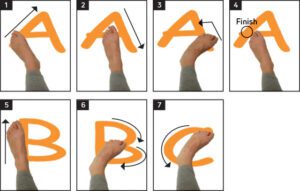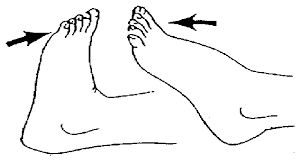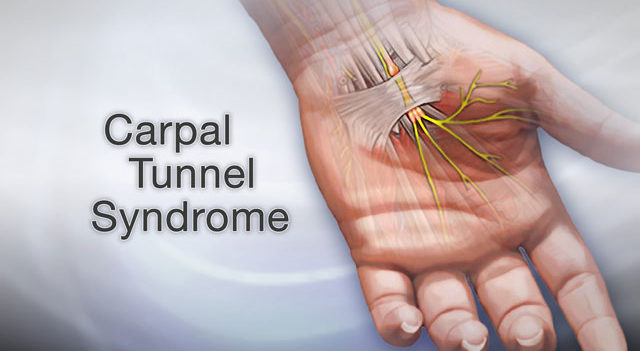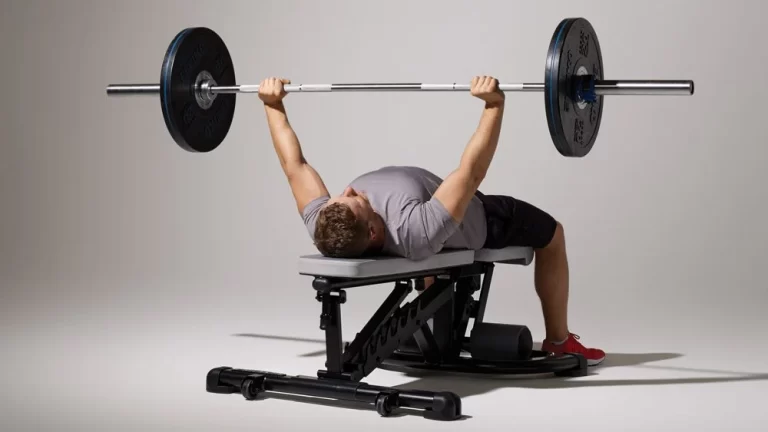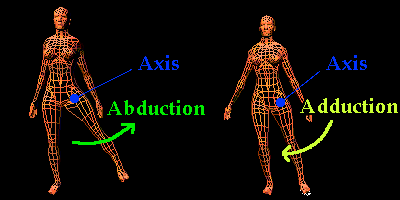Ankle Range of motion exercise: Active, Active assisted and Passive exercise
Ankle Range of motion exercise is a great option to improve mobility of the Ankle joint and there are many health benefits associated with it. It can be Active, Passive or active assisted exercise.
Table of Contents
What is the Ankle Range of motion exercise?
- Ankle Range of motion is the capability of the joint to go through its complete spectrum of motion. The range of motion of the joint can be passive, active-assisted, or active.
- This is refer to an activity aimed at improving the motion of the Ankle joint. This movement is influenced by several structures including the configuration of bone surfaces within a joint, joint capsule, ligaments, tendons, as well as muscles acting on a joint.
There are mainly three types of Ankle range of motion exercises
- Passive range of motion: Motion applied to the ankle joint only by other person or persons or a passive motion machine. When the passive range of movement is applied, the ankle joint of an individual receiving exercise is completely relaxed whereas the outside force moves the body part, such as the ankle, throughout the available range.
- Active assisted range of motion: Ankle Joint receives partial assistance from an outside force. This range of movement may result from the majority of the movement applied by the therapist or by the person or persons assisting the individual. It also can be a half effort on the ankle joint from each source.
- Active range of motion: Movement of the ankle joint provided entirely by the individual performing the exercise. In this type of exercise, there is no outside force aiding in the movement.
How do measure the range of motion of the ankle?
- Devices to measure a range of motion in the joints of the body include the Goniometer and Inclinometer. Both devices use a stationary arm, protractor, fulcrum, as well as movement arm to measure an angle from the axis of the joint.
- Of all the types, the universal goniometer is most widely used as well as comes in two forms: short arm as well as long arm.
- The short arm goniometer is mainly used for smaller joints, namely the wrist, elbow, or ankle, and the long arm goniometer is more accurate for joints with long levers, namely the knee and hip joints.
- Tape measures can also be used to measure a range of motion in some specific parts of the body, such as the lumbar range of motion.

Normal range of the ankle joint
- Ankle dorsiflexion: 0 degree to 20 degrees
- Ankle plantaerflexion:0 degree to 50 degrees
- Ankle inversion: 0 degree to 20 degrees
- Ankle eversion: 0 degree to 10 degrees.
Passive Ankle range of motion exercise
- Passive range of motion exercise is useful for the joints that have become inactive owing to injury or paralysis. In a passive range of motion exercises, the patient does not perform any motion themselves; instead, the physiotherapist moves the limb or body part of the stiff joint, gently stretching muscles as well as reminding them how to move correctly. In most cases, therapeutic stretching exercises are also mixed with passive range of motion exercises to promote faster recovery of the stiff joint. Here, the physiotherapist stretches the soft tissue of the ankle to relax the surrounding muscles as well as relieve tension. Passive range of motion exercises also assists minimize stiffness as well as rigidity in the ankle joint that has been immobilized.
- Some of the most common as well as safest passive range of motion exercises are related to stretching the surrounding muscles with the goal to improve muscle flexibility. One way to do this is with the tool namely, a stretching strap. This will assist the patient hold a stretch for a more sustained period of time, but having a therapist who assists with the stretch is a more effective way to practice passive range of motion exercises. With this type of exercise, a trained professional moves the body into the stretch as well as holds it, with the intent to improve muscle flexibility. This is superior for a few reasons. First of all, the therapist understands proper limits as well as knows how far to go. Secondly, the therapist knows how long to hold the stretch. The physical therapists are also trained to know if it is targeting the proper areas to achieve more benefits. With that in the mind.
In which conditions the therapist should apply a passive range of motion exercise
- Passive range of motion(PROM) exercises are typically used where there is paralysis, when a patient is comatose, in the presence of the healing fracture, or if the pain is elicited while an active muscle contraction.
- One of the main goals of Ankle passive range of motion exercise (PROM) is to counteract the detrimental effects of immobilization, but it is important to remember that this type of (PROM) exercise cannot prevent muscle atrophy.
Benefits of passive range of motion exercise
- This type of exercise not only helps in promoting healthy joint functionality but also benefits the patient in reducing pain, promoting healing, restoring as well as maintaining range of motion (ROM) in certain injured joints, and building muscle mass, allowing for better blood flow as well as aids in increasing oxygen levels.
Various passive range of motion exercises
- Passive dorsiflexion
- First of all, tell the patient to take a relaxed position, like lying on the bed with the knee straight and the foot should out of the bed. Then, the therapist cups the heel with one hand as well as places the other hand on the bottom of the foot. After that, the therapist gently pushes the foot up so that the toes point toward the head of the patient. Perform this exercise ten times per session. Do three sessions per day.

- Passive plantarflexion
- To begin with, the therapist should give the command to the patient, to take a relaxed position, such as lying on the bed with the knee straight and the foot should out of the bed. After that, the therapist cups the heel of the affected foot with the one hand as well as places the other hand on the bottom of the foot. Then, the physiotherapist gently pushes the foot down so that the toes point away from the body. The therapist should make sure that do not hold this position at the endpoint. Perform this exercise 10 times in one session. Do 3 sessions in one day.

- Passive inversion
- To begin with, ask the patient to take a relaxed position, such as lying on the bed with the knee straight as well as the foot should out of the bed. After that, the physiotherapist cups the heel with the one hand and places the other hand on the bottom of the foot as well. Then, the physiotherapist gently turns the foot inward, not allowing the leg to rotate. Perform this exercise ten times in one session. Do three sessions in one day.
- Passive eversion
- First of all, the therapist should give the command to the patient to take a relaxed position, like lying on the bed with the knee straight and the foot should out of the bed as well. Then, the therapist cups the heel with one hand as well as places the other hand on the bottom of the foot. After that, the therapist gently turns the foot outward but does not allow the leg to rotate. Perform this exercise ten times per session. Do three sessions per day. After two to three days increase the number of repetitions as well as improve the number of sessions per day.

- Alphabet
First of all, tell the patient to take a sitting position, with the leg slightly bent, and the foot resting on the ground, moving only
the foot as well as ankle, and “write” each letter of the alphabet from A to Z. Try not to move the knee or even hip too much while doing this Exercise. The letters should start out small as well as get larger as the ankle movement improves. - Passive Ankle Rotation
- With the knee straight as well as one hand holding the ankle steady, place the other hand around the foot as well as turn the foot inward, then outward.

- Passive ankle dorsiflexion with the use of a towel or Belt
- To embark with, the therapist tells the patient to sit with the leg extended as well as knee straight. Then, place a towel or belt around the ball of the foot. After that, hold each end of the towel in the therapist’s hands, and pull back with the towel so that the foot moves toward the face side. The patient should feel the stretch in the calf as well as the hamstring.

- Passive ankle inversion with the use of a towel or Belt
- First of all, the therapist asks the patient to sit with the leg extended and knee straight as well. After that, place a towel or belt around the ball of the foot, then hold each end of the towel in the hands, as well as move the foot inward passively.
Do ten times per session, and perform three sessions per day.

- Passive ankle eversion with the use of a towel or Belt
- To begin with, the therapist tells the patient to sit with the leg extended as well as the knee straight. Then, place a towel or even belt around the ball of the foot, after that hold each end of the towel in the therapist’s hands, and moves the foot outward passively. Do 10 times per session, and perform three sessions in one day.
- Passive toe extension
- To start with, sit on the chair, and place the foot to be exercised across the opposite knee. Then, the patient place one hand on the heel and another hand on the toes, after that, move the toes up towards the shin of the tibia as far as comfortable. Do ten times per session, and do three sessions per day.
- Passive toe flexion
- To embark with, the therapist tells the patient to take a sitting position on the chair and put the foot to be exercised across the opposite knee. After that, the patient put one hand on the bottom of the heel and another hand on the toes, then moves the toes down towards the shin of the tibia as far as comfortable. Do ten times per session, and do three sessions per day.

- Passive toe extension against the step
- First of all, place the toes against the bottom of the wall/step resting the heel on the floor. After that, gently lean into the wall putting pressure through the toes, and pushing them back towards the shin of the tibia, but do not hold this position. Perform this exercise ten times per session, and do three sessions per day.
Active-assisted Ankle range of motion exercises
- As the name suggests, these exercises involve partial assistance from the therapist or from the patient himself. The patient does most of the motion, but he/she gets a little assistance to complete the motion correctly. In most cases, this restricted movement is a result of weakness or pain caused because of falls, bruises, or accidents, up to serious injuries. The physiotherapist mostly uses a strap or a band to secure the joint before helping the motion. In the starting, the patient can suffer a great deal of pain as well as a weakness when performing these exercises, but with time, the patient has a great scope for gradual as well as lasting improvement in the range of movement around the ankle joint.
Some benefits of the active-assisted range of motion exercise
- Improve movement of the ankle joint.
- Increase the function of the ankle joint as well as the whole limb.
- Increase movement efficiency.
- Improve independence.
- Helps Reduce Ankle pain.
- Improve as well as maintain joint integrity.
Various active-assisted range of motion exercises
- Active-assisted dorsiflexion
- To begin with, tell the patient to take a relaxed position, such as lying on the bed with the knee straight and the foot should out of the bed. After that, the physiotherapist cups the heel with the one hand and places the other hand on the bottom of the foot as well. Then, the therapist gives the command to the patient that moves the foot upward as far as the patient can, and when the patient is not able to move the foot between the movement, the therapist assists the patient to reach a full range of the dorsiflexion. Thus, the toes move towards the face side. Perform this exercise 10 times in one session, and do three sessions in one day.
- Active-assisted plantarflexion
- To embark with, ask the patient to take a relaxed position, like lying on the bed with the knee straight as well as the foot should out of the bed. Then, the examiner cups the heel with the one hand as well as places the other hand on the bottom of the foot. After that, the physiotherapist gives the command to a patient that moves the foot down as far as the patient can, and when a patient is not able to move the foot between the movement, the physiotherapist assists the patient to reach a full range of the plantarflexion. In the end, the toes should be away from the face. Perform this exercise ten times per session, and do 3 sessions per day.
- Active-assisted inversion
- First of all, tell a patient to take a relaxed position, like lying on the bed with the knee straight as well as the foot should out of the bed. Then, the therapist cups the inner border with the one hand as well as places the other hand on the bottom of the foot. After that, the physiotherapist gives the command to a patient that moves the foot inward as far as the patient can, and when a patient is not able to move the foot inward in between the motion, the therapist assists the patient to reach a full range of the inversion. Perform this exercise ten times per session, and do 3 sessions per day.

- Active-assisted eversion
- To embark with, tell the patient to take a relaxed position, such as lying on the bed with the knee straight and the foot should out of the bed. After that, the physiotherapist cups the inner border with the one hand and places the other hand on the bottom of the foot as well. After that, the therapist gives the command to the patient that moves the foot outward as far as the patient can, and when the patient is not able to move the foot outward in between the movement, the physiotherapist assists the patient to reach a full range of the eversion. Perform this exercise ten times per session, and do three sessions in one day.
- Active assisted toe flexion
To start with, tell a patient to take a relaxed position, like lying on the bed with the knee straight and the foot should out of the bed as well. Then, the therapist cups the toes with one hand as well as places the other hand on the bottom of the foot. After that, the physiotherapist gives the command to the patient that moves the toes toward the floor as far as the patient can, and when the patient is not able to bend the toes in between the movement, the therapist assists the patient to reach a full range of the toe flexion. Perform this exercise 10 times in one session, and do 3 sessions per day. - Active-assisted toe extension
- To begin with, ask the patient to take a relaxed position, such as lying on the bed with the knee straight as well as the foot should out of the bed. After that, the physiotherapist places the strong hand on the backside of the toes as well as places the other hand on the bottom of the foot. Then, the therapist gives the command to a patient that moves the toes upward means toward the face side as far as the patient can, and when the patient is not able to extend the toes in between the motion, the physiotherapist helps the patient to reach a full range of the toe extension. Perform this exercise ten times in one session, and do three sessions per day.

Active Ankle range of motion exercises
- This type of exercise is mainly performed by the patient himself because the patient is entirely capable to perform these exercises, and most often, the physical therapist’s involvement is limited to verbal cues as well as directions on how to improve the posture as well as movement involved in the exercises.
- This is most useful in cases of minor injuries such as Ankle sprain that do not severely restrict the motion of the ankle, but this can be painful, uncomfortable, or even hindering.
Various active range of motion exercises
- Active ankle circles
- Ankle circles can help with the range of motion. A patient can do ankle circles from either a sitting or lying position:
- To start by turning the ankle around slowly in circles to the left side, then the right side. A patient can even find this exercise easier to try drawing the alphabet in the air with the foot. Lead this exercise with the big toe. Keep the motions small in the starting and focus on only using the foot as well as the ankle, not the entire leg. For circles, try doing ten in each direction with the affected foot. If a patient is doing the alphabet, complete three sets of this exercise on the affected foot per day. After two to three days, increase the number of repetitions in every session.
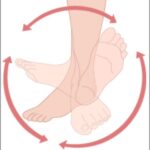
- Toe extension
- Toe extension exercise is useful in preventing or treating plantar fasciitis, which is a condition that causes pain in the heel while walking as well as difficulty raising the toes.
- To do this exercise: First of all, tell the patient to take a sit-up straight in the chair, with the feet flat on the floor. Then, place the injured foot on the normal thigh. Then, pull the toes upward toward the ankle. There should be a stretching feeling along the bottom of the foot and the heel cord. Hold for 30 seconds. Massaging the arch of the foot while stretching will help ease tension as well as pain. Repeat the toe extension exercise 3 times on each foot. Do 3 repetitions per session. Do 3 sessions per day.
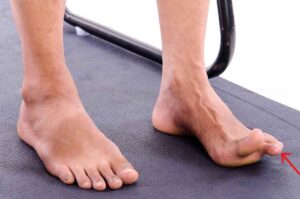
- Toe flexion
- To do this exercise:
- Tell a patient to take a sit-up straight on the chair, with the feet flat on the floor. After that, place the left foot on the right thigh. Then, move the toes down toward the floor side. After that, hold for 30 seconds, then release it. Do three repetitions in one session. Do three sessions in one day.
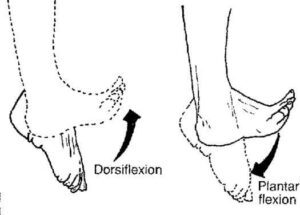
- Active dorsiflexion range of motion exercise
- To embark with, ask the patient to take a relaxed position, such as lying on the bed. After that, the physiotherapist should give the command to the patient to bend the foot toward the face side meaning upward as long as the patient can. At the endpoint, the hold would not be taken. Repeat ten times per session. Do 3 sessions in one day. As the muscles become stronger increase the number of repetitions from 10 to 15 and 20 in one session.
- Active plantar flexion range of motion exercise
- To start with, tell the patient to take a relaxed position, such as supine on the bed. After that, the therapist should give the command to the patient to move the foot away from the body means down as far as the patient can but at the endpoint, the hold should not be taken. Repeat ten times in one session per set. Do three sessions per day. As the muscles become stronger increase the number of repetitions from ten to fifteen and twenty per session.
- Active ankle inversion range of motion exercise
- To start with, tell the patient to take a relaxed position, such as lying on the bed. Then, the physiotherapist should give the command to a patient to move the foot inside as long as the patient can, but at the endpoint, the hold should not be taken. Repeat ten times in one session per set. Do 3 sessions in one day. As the muscles become stronger increase the number of repetitions from ten to fifteen to twenty per session.
- Active ankle eversion range of motion exercise
- First of all, tell the patient to take a relaxed position, such as lying on the bed. Then, the therapist should give the command to the patient to move the foot outside as long as the patient can, but at the endpoint, a hold should not be taken. Repeat ten times per session per set. Do three sessions in one day. As the muscles become stronger increase the number of repetitions from 10 to 15 to 20 in one session.
- Alphabet
- To embark with, draw the letters of the alphabet in the air by imaging with the foot. Do lowercase and uppercase letters, as well as make sure to move from the ankle, not from the hip joint. Do 10 times in one session but do not hold at the endpoint. Do 3 sessions per day.
